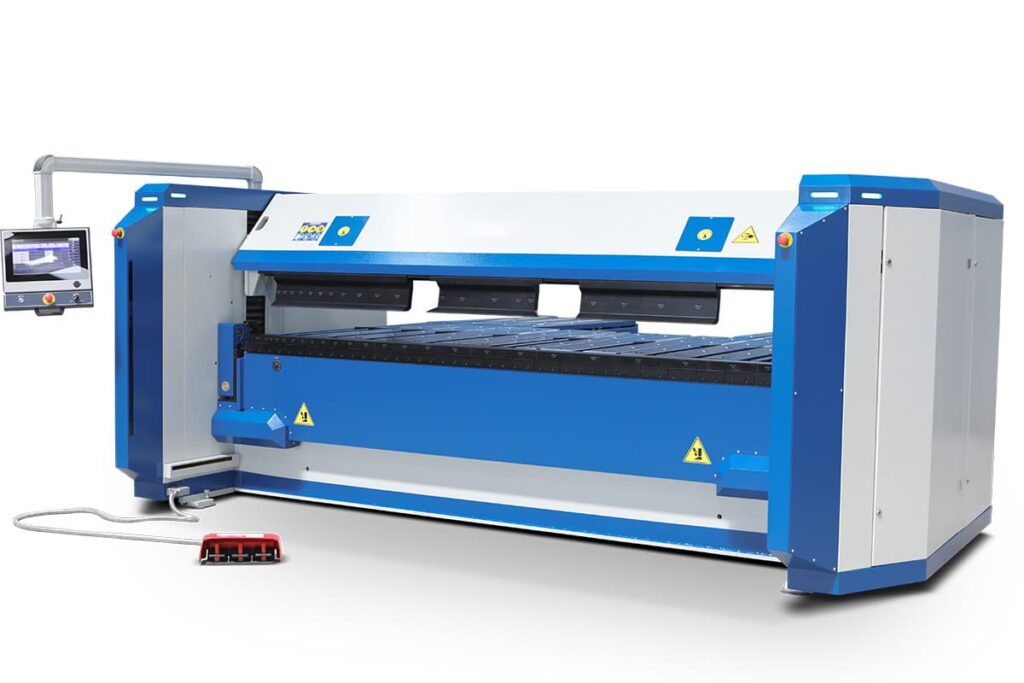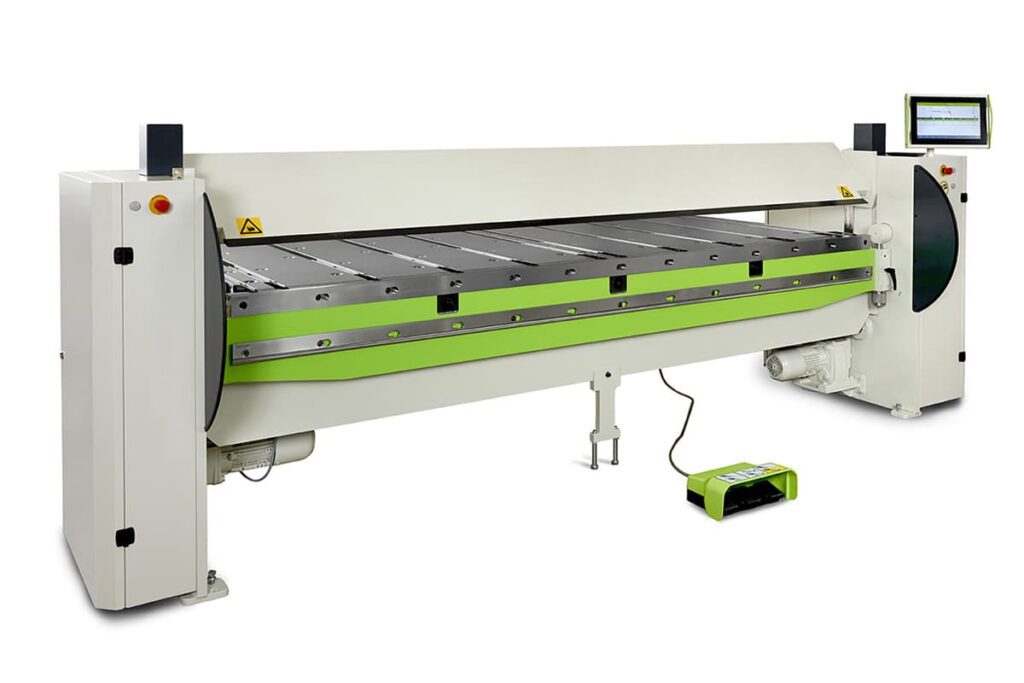In the realm of metal fabrication, the machine you choose will leave a deep influence on your work quality, operation efficiency as well as final success. The most common machine used in the manufacture is press brake and folding machine. Both are elementary tools for bending and shaping metal, and have their distinctive features, which can be applied for different kinds of tasks. It is not easy to decide which one is better. You need to look into the function, and the specific needs of the workshop. This article aims to delve into the intricacies of the two machines: functions, applications and their advantages and disadvantages. By understanding these aspects, companies can choose which machine is best suited to their specific needs, thus further improving their productivity and profitability in the metal fabrication industry. Press brake is a machine punch tool used for sheet bending, and the most common one is metal sheet. It helps form predetermined bending between the matching punch and die via clamping the workpiece. This workpiece includes positioning and fixing the workpiece. At the same time, the punch lowers to force the material to bend. Press brake features a variety of types, and each type has its own operation method and application. The main types are mechanical, hydraulic, pneumatic, and servo-electric press brake. The mechanical press brake uses the flywheel and crank mechanism to exert pressure, and hydraulic adopts hydraulic oil to generate pressure. The pneumatic one utilizes the air pressure, and the servo-electric press brake uses servo motor to drive the ram mechanically. All have their benefits and weaknesses, which can be applied to different programs and working environment significantly. Press brake plays a pivotal role in the program required for thick specification metal sheet. It generates complex, tight bending ideal materials in thick materials, which makes it indispensable for automotive manufacturing, aircraft production, and heavy machinery construction. It boosts precision and power, which helps give high priority to the high accurate and repeatable tasks. The apparent feature of press brake is functionality. It can deal with various materials and thickness, complex bending angles and shapes, which makes it essential for most metal fabrication workshop. What’s more, by using the proper tooling, press brake can operate assorted bends, such as air bending, coining, and bottoming. Furthermore, modern press brake is equipped with CNC system, which improves its accuracy and repeatability. Although press brakes feature many advantages, they still restrain some restrictions. Due to large size, they need to occupy abundant space. Meanwhile, because of the complex bending operation, they need an experienced and skillful operator to operate. Additionally, press brakes could be slower than other bending machines, especially when dealing with intricate bending or large production volumes. Safety is essential for operating the press brake. Owing to the force it exerts, improper utility may cause severe accidents. The operator should accept training in safety regulations, including the uses of safety guards and the importance of maintaining and regularly checks. Furthermore, modern press brake usually have advanced safety functions, such as laser safety device, for protecting the operator. A folding machine, also known as a folder, is a precise machine tool used for bending and folding metal. Unlike the press brake using punch and die, it adopts another concepts to operate. The folding machine adopts clamping workpiece between upper beam and bottom beam. The third beam is called folding beam, which swings to fold the metal along the desired line. The bending beam in folding machine is the key accessory for realizing the bending process. It moves against the clamped material, producing a rotation that results in folding. This strategy can make the machine work on delicate surfaces instead of damaging the workpiece. Thus the folding machine is very suitable for thinner, coated, or lacquered plates. The folding machine is applicable for thinner and lighter materials, and are often used in metal sheet industries that require precise, consistent folding. It is often used in roofs, pans, trays, and covers components creating. Also, it is very suitable for small and medium manufacture, which benefits the efficiency and productivity. One of the advantages of folding machine is to handle the fine and coated materials without causing any damages. At the same time, it boosts high precision and is very suitable for tasks requiring accurate bending. The folding machine is more compact than press brake, and is usually operated by one operator, thus decreasing the labor cost. Additionally, owing to lack of punch and die, it shortens the tool configuration time, making it become the ideal choice for small batch production. Compare with press brake, the folding machine is not suitable for handling large size metal sheet. Although it performs well in creating consistent and precise folding, it is not prevalent in creating various bending types. At last, the initial investment of high quality folding machine maybe significant, although this is often offset by the efficiency and productivity benefits of the machine. In all, it is paramount for you to know a lot about the function of folding machine, the concept of bending beam, application and advantages and disadvantages, which is beneficial for most metal sheet fabrication. These knowledge help you make wise decision when choosing the machine to ensure the operation’s efficiency, quality and safety. The difference between press brake and folding machine is large in bending sequences. In press brake, the operator put the workpiece outside the machine and keep it, and the top punch moves downward into bottom die to form bending. In contrast, the folding machine allows for workpiece being put on the table, with only the portion to be folded protruding. Then the bending beam moves to create bending. Setting the press brake usually requires assorted punches and dies, which may lead to longer setting time. On the other hand, the folding machine only uses one set of tooling to bend all the angles, and it can be adjusted automatically according to the thickness of materials, which shortens the setting time and effort, and produces higher efficiency for small batch sizes. The method for handling material thickness tolerances varies between press brake and folding machine. In press brake, the punch contacts the material from the above, and contacts the “Vâ€Â mold from the bottom, which means the sheet thickness tolerance may result in angle changing. On the contrary, the folding machine only contacts the outside of the material, so the thickness tolerance of the plate will not affect the bending angle. The press brake usually gauge the short flange, with the long flange protruding from the machine. This may lead to blank tolerances showing up in the overall dimensions of the finished part. However, the folding machine gauge the whole component parts, which means blank tolerances only appear in the first flange, ensuring the overall dimension and opposite flanges are always accurate. The folding machine performs well in dealing with sensitive materials surfaces, which decreases the sliding area of the tools on the surfaces to the minimum, and makes it become the ideal choice for stainless steel or coated sheet. Press brake, however, will draw the material over the edges into the "V" die, resulting in apparent scratches on the sheet, making them less ideal for sensitive materials. Tool wear is another important element. In folding machine, the slight relative movement between the blade and material surfaces can decrease the tool wear to the minimum. On the other hand, the press brake have a long sliding distance on the edge of “Vâ€Â mold. With the time passing by, it will cause severe tool wear. Both the two machines can create radii and hems, but differ in process. The folding machine can create any radii under the circumstance of no special tools, and the bending process is invisible from the outside. In the contrast, press brake requires special tools for hemming, and maybe more difficult to create radii via bending process. So, although the press brake and the folding machine have similar functions, they still vary greatly in operation, setting, materials handling and tool wear. It is of vital importance for you to know these differences to choose your required metal fabrication machine. Making a choice between the press brake and folding machine is of vital paramount, which will impact the metal fabrication efficiency, quality and profitability ability. When making this decision, several factors come into play. The first element you should consider is the nature of your work. If your programs require large size metal sheet, complex and tight bending, the press brake could be the ideal choice. However, if your tasks need lighter and thinner materials, accurate and consistent bending, the folding machine is more acceptable. Cost is also the key factor. Though initial investment of high quality folding machine is large, with the time passing by, its efficiency and productivity benefits can offset this cost. Operating the press brake maybe not expensive, but it requires several operators and longer setting time, thus the higher operating cost may occur. The anticipated return on investment (ROI) is also essential to consider. It contains evaluating the potential revenue that a machine can generate over its lifespan, considering factors such as its productivity, efficiency, and demand for the products it can produce. The type of work, cost, and expected return on investment are interrelated factors which should be considered together. The type of work determines the suitability of the machine, the cost affects the financial feasibility of the investment, and the anticipated return on investment provides a prediction of investment profitability. Balancing these factors is the key to making wise investment decisions. In some cases, it is beneficial to have both two machines. If your projects are related to various programs which require complex and tight bending on the thick metal sheet, and precise and consistent folding on lighter material, both the two machines can provide versatility that most tasks require in an efficient way. What’s more, if one machine needs maintenance or repair, the other machine can offer you backup options. In a nutshell, it is not easy to make a decision between the press brake and folding machine because there are many factors need to consider. You can make reasonable choice through looking into these factors and the relationship between the machine and your actual needs, thus the the process efficiency, quality and profitability can be improved. In metal fabrication, choosing between a press brake and a folding machine depends on your specific needs, costs, and anticipated returns. Both two have distinctive strengths, and understanding these can guide your decision, enhancing efficiency, quality, and profitability in your operations. Reach out for more information or assistance in choosing the right machinery for your needs. ADH is a professional sheet metal machinery manufacturer with 20 years of experience. The press brake is our flagship product. We can help you choose the right press brake and provide robust after-sales support. If you need information about our press brake, please contact our sales staff or browse our press brake product page. Download the Infographic With High Resolution Combined Type Strapping Tool,Intelligent Bundling Machine With Sensors,Heavy Construction Material Strapping Machine,Secure Bundling Equipment for Transport YANBIAN LONGCHUAN PACKING MACHINERY CO., LTD , https://www.yblcmachinery.comI. Introduction
II. Understanding the Press Brake

1. Definition and Functionality of Press Brakes
2. Types of Press Brake
3. Ideal Applications
4. What Are the Advantages of Press Brake Machine
5. What Are the Disadvantages of Press Brake Machine
6. Safety Considerations
III. Understanding the Folding Machine

1. Definition and Function
2. Bending Beam
3. Ideal Application
4. Advantages of Folding Machine
5. Disadvantages of Folding Machine

IV. What Is the Difference Between a Press Brake and a Folding Machine
1. Comparison of the Bending Sequences
2. Comparison of Machine Setup
3. Impact of Material Thickness Tolerances
4. Comparison of Gauging Methods
5. Handling of Sensitive Material Surfaces
6. Tool Wear in Both Machines
7. Bending Radii and Hems in Both Machines
V. Deciding Between a Press Brake and a Folding Machine
1. Factors to Consider When Choosing Between the Two Machines
2. Consider the Importance of Job Types, Costs, and Anticipated Investment Returns
3. Scenarios Where Having Two Machines Simultaneously May Be Beneficial
VI. Conclusion
